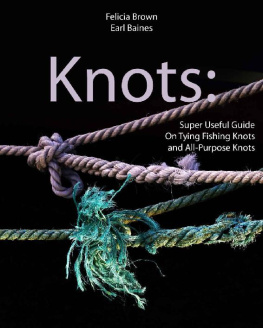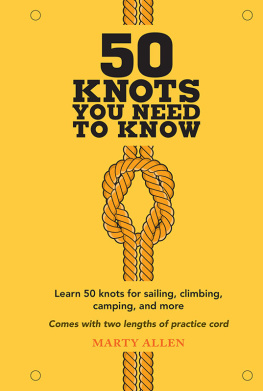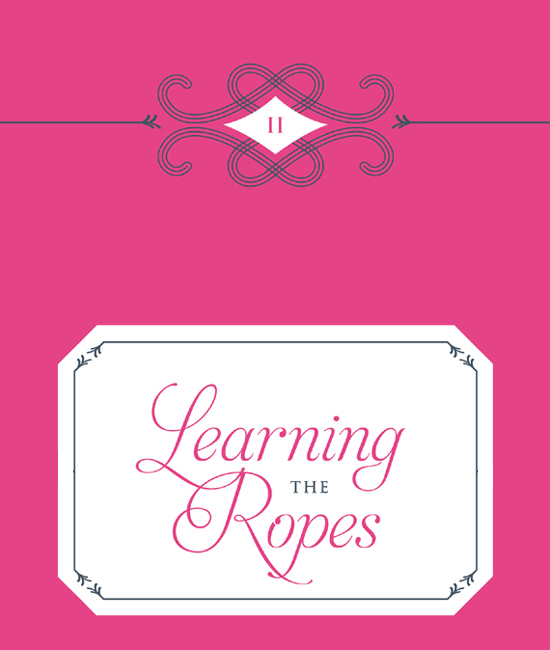POTTER STYLE
Copyright 2013 by Potter Style. All rights reserved. Published in the United States by Potter Style, an imprint of the Crown Publishing Group, a division of Random House, Inc., New York.
www.potterstyle.com
ISBN 978-0-7704-3451-9
ebook ISBN 978-0-7704-3518-9
Cover design and illustrations by Danielle Deschenes
Interior illustrations by John Tomaselli
Design by Danielle Deschenes and Maria Elias
v3.1
Contents
Introduction: In Lust We Trust
Bedroom bondage isnt simply about finding pleasure in pain. It is also about experimenting with control and surrender. Adding sensual knot-tying to your repertoire should be a gradual and consensual experience. For most people, a little goes a long way.
If you and your partner trust each other enough to push the boundaries of intimacy, then bondage can literally and emotionally strengthen your sense of connection. Begin with a simple blindfold and a set of props that engage the senses in different ways (see immobilizing maneuvers. Throughout the process, openly communicate your likes, dislikes, and desires.
Rather be tied up than tied down? This book also contains several knot-tying adornments that are designed to arouse the wearer and the viewer. There are instructions for creating a few naughty toys out of rope. Finally, learn to perform a burlesque self-tying rope routine that is much easier than twirling pasty tasselsand perhaps more attention-getting.
Be prepared; tying knots requires a little practice in advance. Keep this book on your bedside table in case you need a little refresher, or leave it on your partners pillow to send a not-so-subtle signal: Its time to get knotty!
KNOTTY DO s

Take every sensible precaution when you play with rope; tying someone improperly can cause serious pain and injury. Forming strong bonds begins with these safe practices:

Your Safe Word: Straightforward communication is the best place to start, but if youre inclined to say No, stop! when you actually mean Yes! Yes! you should establish another word to indicate that it is time to back off.
Keep It Loose: When tying a restraint, keep one or two fingers between the rope and the body to prevent it from becoming dangerously tight. Once the bond is secured, check to make sure you can still slide at least one finger under the ropes, especially at the joints (wrists, ankles, knees, elbows), where major arteries and veins are vulnerable.
Learn to Come Undone: Be confident that you can tie and untie a knot before trying it out on your partner.
Make the Cut: Keep a pair of safety scissors (aka bandage scissors or EMT scissors) nearby in case you need to cut the ropes in an emergency. Safety scissors have a blunt-ended blade so that you wont harm your partner as you cut through the rope.
Know Your Own Limits: Modify the instructions in this book to suit your own flexibility and comfort level. Dont tolerate pain, and never let emotional discomfort escalate to the point of panic.
KNOTTY DONT s

Consider these points to be out of bounds:

No Tie Required: Scarves and neckties may seem like obvious materials for bondage, but cloth can become too tight under tension. Use these accessories as blindfolds only.
Never Go Numb: Tell your partner if a bond is causing numbness or a pins-and-needles sensation. Your partner should also check to make sure your bound extremities arent unusually cool or turning white or blue. These are all signs of disrupted circulation, which can lead to nerve and tissue damage.
No Necking: Never tighten a rope around the neck or allow the neck to bear tension. A collar should be used for decorative purposes only.
Spare the Suspense: Dont experiment with suspension bondage (where the bound persons weight must be supported by a fixture) without expert training and equipment. There is no suspension bondage in this book.
Dont Go Solo: Never leave someone who is restrained alone. Circulation issues can arise within minutes, and of course you wouldnt want a helpless partner to be harmed if an unforeseen accident or emergency occurred in your absence.
A BEGINNERS GUIDE TO ROPES

A trip to the hardware store will never seem the same after youve shopped for these sensual supplies. There are many types of rope available, and they all behave differently when used for sensual knot-tying. This cheat sheet will help you find the right rope for your needs.

Synthetic: Synthetic (usually nylon) rope is inexpensive, readily available, and strong. It is probably the best bet for true beginners, as it is smooth against the skin and is difficult to tie too tightly. Purchase twisted rope or solid braid rope, not rope with a core (which will be stiffer and harder to tie into stable knots).
Cotton: Cotton rope is inexpensive and easy to find. It is stiff at first, but will soften after it is washed. Pure cotton rope holds knots firmly and bites into the skin more than nylon rope. Cotton clothesline rope often has a plastic core, which makes it less bondage-friendly. Generally, cotton frays and breaks more easily than nylon rope, and is not suitable for any kind of suspension bondage.
Hemp (or Jute): Jute is used in traditional Japanese bondage, but it is expensive and hard to find. Hemp is the usual substitute. Natural-fiber enthusiasts beware: Raw hemp rope is too splintery and rough for bondage. It can be used after extensive preparation, but is probably best left for the experts.
BEYOND THE BASICS















